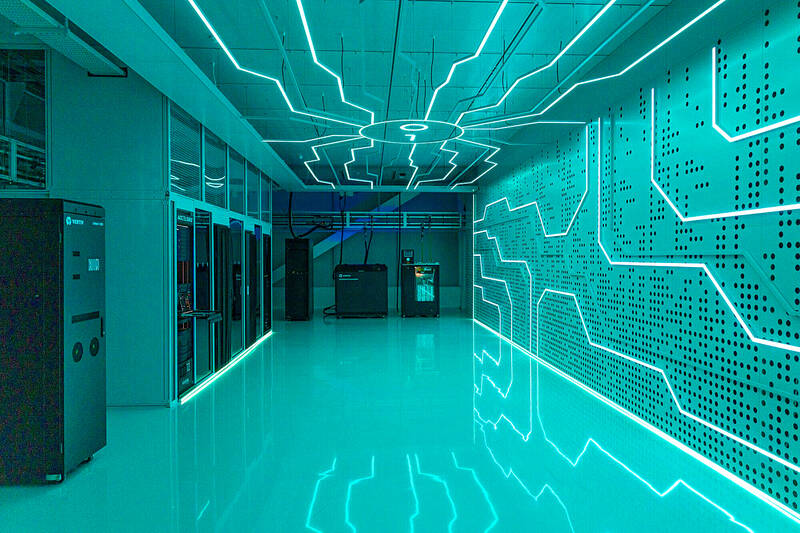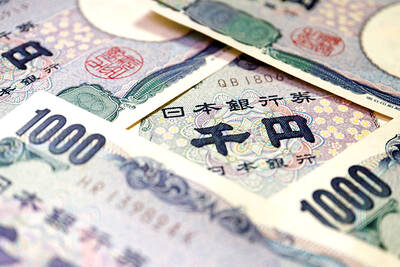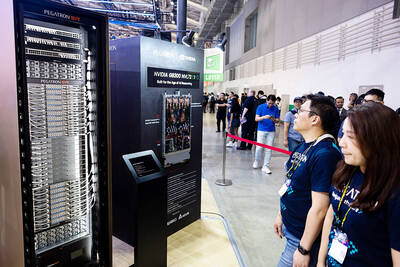The credibility of climate pledges by the world’s tech giants to rapidly become carbon neutral is fading fast as they devour more and more energy in the race to develop artificial intelligence (AI) and build data centers, researchers warned on Thursday.
Apple, Google and Meta said they would stop adding carbon dioxide into the atmosphere by 2030, while Amazon set that target for 2040. Microsoft promised to be “net negative” — pulling carbon dioxide out of the air — by the end of this decade.
However, those vows, made before the AI boom transformed the sector, are starting to look like a fantasy, even as these companies have doubled down on them, according to independent analysts.

Photo: Bloomberg
“The greenhouse gas emissions targets of tech companies appear to have lost their meaning,” said Thomas Day, lead author of a report by think tanks Carbon Market Watch and NewClimate Institute.
“If energy consumption continues to rise unchecked and without adequate oversight, these targets will likely be unachievable,” he added.
The deep-dive analysis found the overall integrity of the climate strategies at Meta, Microsoft and Amazon to be “poor,” while Apple’s and Microsoft’s were deemed “moderate.”
When it came to the quality of emissions reduction targets, those of Meta and Amazon were judged “very poor,” while Google and Microsoft scored a “poor” rating. Only Apple fared better.
The expanding carbon footprint of the five top tech behemoths stems mostly from the breakneck expansion of AI, which requires huge amounts of energy to develop and run.
Electricity consumption — and the carbon emissions that come with it — has doubled for some of these companies in the last three or four years, and tripled for others, the report found.
The same is true across the sector: Operational emissions of the world’s top 200 information technology companies were nearly 300 million tonnes of carbon dioxide in 2023, and nearly five times that if the downstream use products and services are taken into account, according to the UN’s International Telecommunications Union.
If the sector were a country, it would rank fifth in greenhouse gas emissions, ahead of Brazil. Electricity to power data centers increased on average 12 percent per year from 2017 to last year, and is projected to double by 2030, according to the International Energy Agency.
If all this extra power came from solar and wind, carbon dioxide emissions would not be rising. However, despite ambitious plans to source their energy from renewables, much of it is still not carbon neutral. Studies estimate that half of the computing capacity of tech companies’ data centers comes from subcontractors, yet many companies do not account for these emissions, the study said.
The same is true for the entire infrastructure and equipment supply chain, which accounts for at least one-third of tech companies’ carbon footprint.
“There is a lot of investment in renewable energy, but overall, it has not offset the sector’s thirst for electricity,” Day said.
Given the status of AI as a driver of economic growth, and even as a vector for industrial policy, it is unlikely that governments are going to constrain the sector’s expansion, the report said.
“So far the whole AI boom has been altogether quite unregulated,” Day said.
“There are things these companies can and will do for future proofing, to make sure they’re moving in the right direction” in relation to climate goals, he added. “But when it comes to decisions that would essentially constrain the growth of the business model, we don’t see any indications that that can happen without regulatory action.”
The report identified a number of ways in which the tech sector could curb its carbon footprint, even as it develops AI apace. Ensuring that data centers — both those belonging to the companies as well as third party partners — run on renewable electricity is crucial.
Increasing the lifespan of devices and expanding the use of recycled components for hardware production could also make a big difference.
Finally, the methods used for calculating emissions reduction targets are out of date and in need of revision, the report said.

AI TALENT: No financial details were released about the deal, in which top Groq executives, including its CEO, would join Nvidia to help advance the technology Nvidia Corp has agreed to a licensing deal with artificial intelligence (AI) start-up Groq, furthering its investments in companies connected to the AI boom and gaining the right to add a new type of technology to its products. The world’s largest publicly traded company has paid for the right to use Groq’s technology and is to integrate its chip design into future products. Some of the start-up’s executives are leaving to join Nvidia to help with that effort, the companies said. Groq would continue as an independent company with a new chief executive, it said on Wednesday in a post on its Web

RESPONSE: The Japanese Ministry of Finance might have to intervene in the currency markets should the yen keep weakening toward the 160 level against the US dollar Japan’s chief currency official yesterday sent a warning on recent foreign exchange moves, after the yen weakened against the US dollar following Friday last week’s Bank of Japan (BOJ) decision. “We’re seeing one-directional, sudden moves especially after last week’s monetary policy meeting, so I’m deeply concerned,” Japanese Vice Finance Minister for International Affairs Atsushi Mimura told reporters. “We’d like to take appropriate responses against excessive moves.” The central bank on Friday raised its benchmark interest rate to the highest in 30 years, but Bank of Japan Governor Kazuo Ueda chose to keep his options open rather than bolster the yen,

Even as the US is embarked on a bitter rivalry with China over the deployment of artificial intelligence (AI), Chinese technology is quietly making inroads into the US market. Despite considerable geopolitical tensions, Chinese open-source AI models are winning over a growing number of programmers and companies in the US. These are different from the closed generative AI models that have become household names — ChatGPT-maker OpenAI or Google’s Gemini — whose inner workings are fiercely protected. In contrast, “open” models offered by many Chinese rivals, from Alibaba (阿里巴巴) to DeepSeek (深度求索), allow programmers to customize parts of the software to suit their

Global server shipments are expected to surge to 15 million units next year, from 4 million units this year, with artificial intelligence (AI) servers accounting for about 30 percent, driven by massive capital spending by major cloud service providers, the Market Intelligence and Consulting Institute (MIC) said on Thursday last week. Major cloud service providers — including Google’s parent company Alphabet Inc, Microsoft Corp, Amazon.com Inc and Meta Platforms Inc — are projected to budget US$450 million for capital expenditure next year, up from US$400 million this year, MIC ICT [information and communications technology] Industry Research Center director Edward Lin